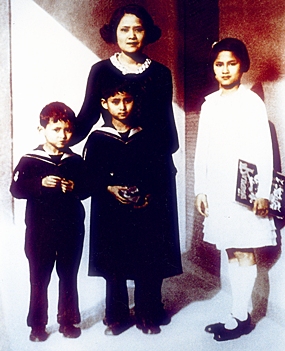The Pattaya Mail Media Group joins the entire Kingdom in humbly extending our best wishes of loyalty and devotion to His Majesty King Bhumibol Adulyadej the Great, the World’s Longest-Reigning Monarch on the auspicious occasion of His 85th Birthday, December 5, 2012.
The following pages contain sometimes repeated, oft quoted excerpts of the incredible life of our most gracious Father of the Thai Kingdom, written by our special correspondent Peter Cummins.
Long Live The King!
 The Pattaya Mail Media Group joins the entire Kingdom in humbly extending our best wishes of loyalty and devotion to His Majesty King Bhumibol Adulyadej the Great, the World’s Longest-Reigning Monarch on the auspicious occasion of His 85th Birthday, December 5, 2012. The following pages contain sometimes repeated, oft quoted excerpts of the incredible life of our most gracious Father of the Thai Kingdom, written by our special correspondent Peter Cummins.
The Pattaya Mail Media Group joins the entire Kingdom in humbly extending our best wishes of loyalty and devotion to His Majesty King Bhumibol Adulyadej the Great, the World’s Longest-Reigning Monarch on the auspicious occasion of His 85th Birthday, December 5, 2012. The following pages contain sometimes repeated, oft quoted excerpts of the incredible life of our most gracious Father of the Thai Kingdom, written by our special correspondent Peter Cummins.
Prologue
It is very difficult to encapsulate the incredible achievements of our beloved King in this short article. The writer, rather, has highlighted just some of the events, honours and accolades which have been dedicated to His Majesty, over the long years of his reign, culminating in this auspicious year of his 85th birthday.
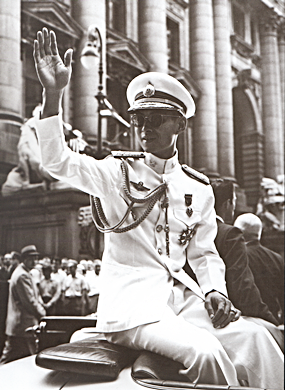
Born on Monday, the fifth of December, 1927 at the Mount Auburn Hospital, Cambridge, Massachusetts, HM King Bhumibol Adulyadej the Great reaches his eighty-fifth birthday, also celebrating sixty six years on the Thai Throne.
In his Coronation Oath, promulgated on the fifth of May 1950, the newly-crowned Rama the Ninth vowed that, “We will reign with righteousness for the benefit and happiness of the Siamese people” and, in the six decades which have passed since that auspicious day, the concept of “righteousness” has dominated his reign.
In fact, HM the King has constantly revered the age-old Buddhist concept of ‘Kingship’ as defined in the Sutta Pitaka of the Tripitaka in which a King is defined as Mahasammata – a King of Righteousness.
Our King has steadfastly reigned by these principles, embodying good kingship in his own life and example and often speaking out against the affliction of the evils so clearly spelled out in the Buddhist philosophy – evils and afflictions which seem to have become progressively worse in the past few tumultuous years.
There will inevitably be some familiar material in parts of this story, for HM the King’s development projects have been ongoing for more than 50 years and there is, of course, a historical perspective which has been incorporated.
As His Majesty reaches his eighty-fifth birthday this day, 05 December 2012, the Thai Nation celebrates again, in a thousand different ways, with every person from the youngest to the oldest renewing the pledge of loyalty and devotion to the beloved King who, during this year also celebrated his sixty-second year of marriage to Queen Sirikit.
2012 – A year of Royal Activities
Thai people are well aware of what he has done for them and recognize His great benevolence in pursuing his concerns for the benefits and happiness of the people. His Majesty recently donated 84 million baht to the start-up fund for the establishment of Utokapat Foundation under his royal patronage. The foundation will work with various water-related agencies in handling water management in Thailand.
The foundation was established because the Thai people suffered severe floods in 2011, when His Majesty called for collective efforts to alleviate the flood problem. He also gave advice on proper water management to ease the flooding situation and the plights of his subjects.
On a sad note, Their Majesties the King and Queen performed the symbolic royal cremation and the actual royal cremation of the remains of HRH Princess Bejaratana on April 9 at the Royal Crematorium at the Sanam Luang ceremonial ground. The only daughter of King Vajiravudh (Rama VI), and the first cousin of His Majesty King Bhumibol Adulyadej, Princess Bejaratana gave an admirable example to follow in her remarkable life.

On July 9, 2012, His Majesty the King, accompanied by Her Majesty the Queen and Her Royal Highness Princess Maha Chakri Sirindhorn, presided over the inauguration of five Royally Initiated Projects for Effective Water Management.
HM the King traveled on board a cruise ship along the Chao Phraya River from Siriraj Hospital to Ko Kret in Nonthaburi to visit riverside communities affected by the severe flooding in 2011. The ship stopped at the Royal Irrigation Department Headquarters in Bangkok, where His Majesty attended the official opening for the five royally initiated projects.
The five projects are located in five provinces, namely Khun Dan Prakan Chon Dam in Nakhon Nayok, Khwae Noi Bamrung Daen Dam in Phitsanulok, Lam Phayang Bhumipat Water Diversion Tunnel in Kalasin, Thoranit Naruemit Sluice Gate in Nakhon Phanom, and Uthokvibhajaprasid Sluice Gate in Nakhon Si Thammarat.
Later in the year, on Oct. 29, 2012, His Majesty the King endorsed Prime Minister Yingluck Shinawatra’s new cabinet.
On Nov. 20 this year, the Badminton World Federation presented His Majesty the King with its President’s Medal. It is the BWF’s highest award to honor distinguished individuals or organizations with an exceptional contribution to the sport, said Charoen Wattanasin, president of the Badminton Association of Thailand. His Majesty was the first person to receive the award, according to Prof Charoen.
His Majesty has played a key role in badminton development in Thailand for more than 50 years. HM the King, who played badminton when he was younger, has also given financial support to the sport through the Crown Property Bureau since 2002.
Because of the King’s contributions, several Thai players have shone on the international stage, including Boonsak Ponsana and 17-year-old Ratchanok Intanon who is one of the brightest young prospects in the world.
Charoen, a former world class player, also received the King’s personal support to study and play badminton in England.
Musical Tributes
There have been so many tributes to our King from all corners of the world over the past couple years, that here it is only possible to outline some of them.
One of the most pervasive has been in the form of Musical Tributes, not surprisingly, as His Majesty is an acknowledged composer of classical music and an exceptionally-talented jazz aficionado.
An Austrian ensemble who, despite never having worked together, recently succeeded in producing an album – the Royal Lullaby – that is faithful to the integrity and authenticity of the original pieces, and in the process created a musical repertoire of international calibre.
 The King of Swing, H.M. King Bhumibol Adulyadej, Benny Goodman and friends at an impromptu jazz session, Manhattan 1960.
The King of Swing, H.M. King Bhumibol Adulyadej, Benny Goodman and friends at an impromptu jazz session, Manhattan 1960.
“It all started last December where we all met for the first time. I played for Her Majesty the Queen and was asked to include His Majesty’s Love In Spring in the programme. I didn’t know the music or what to expect so was very curious and I came here and just fell in love with the music,” said Austrian solo violinist Wolfgang David, one of the musicians who performed for the album.
David and the album’s producer Chris Craker were recently in Bangkok to discuss the assembled work. David also arrived to perform a few pieces from the album at the launch held recently at the Sukhothai Hotel.
The Royal Lullaby album also showcases the talents of the Royal Philharmonic Orchestra, Swiss Conductor Emmanuel Siffert and local pianist Indhuon Srikaranonda. Revered Thai National Artist Prof Manrat Srikaranonda was also involved in the musical production.
Commissioned by Her Royal Highness Princess Galyani Vadhana, the album highlights 10 compositions that reveal HM the King’s musical ingenuity, including the well-known Lullaby and Summertime.
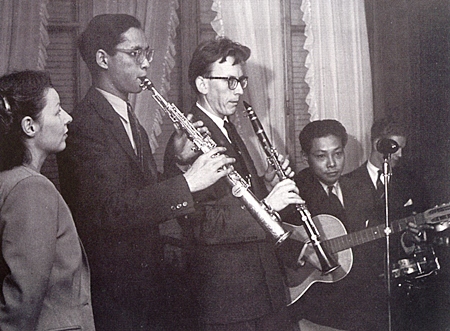
“These works are very important, because I believe Thai musicians have gleaned a lot of influence from Western music, but I think that American and European listeners will appreciate this type of music too,” said David explaining the necessity of creating an album of this stature.
On HM the King’s compositions, David said, “The music is uplifting, which makes it very human. That’s why I love to play it because I also believe that music should lift people’s minds – it’s not just about having a good time for an hour in a concert.”
Craker acknowledged that while His Majesty the King is already a respected figure in the international community, these newly-arranged pieces will further enable Western audiences to enjoy the music.
Craker also noted that the album’s juxtaposition of classical and jazz compositions was quite unusual. “There are elements of Thai folk music in the melodies, but I think His Majesty is greatly knowledgeable on Western music and he has been able to embody all those styles and influences with his own concepts,” he added.
“It’s different in that most of the pieces were already written, but the arrangements were not. The melodies have been around for many years, but this orchestration of them is new. There are no right or wrong arrangements, only how people will feel towards the music.”
As an interpreter of the melodies, Chris Craker understood the responsibility that he had in communicating HM the King’s music to an international audience.
Another tribute to HM the King’s musical talents came from the Nagoya Philharmonic Orchestra which, during the annual Toyota Classics concert featured the internationally-acclaimed Nagoya Philharmonic Orchestra, under the baton of Tatsuya Shimono, showcasing two of HM’s musical masterpieces in its programme; namely Kwam Fun Un Soong Sood (A Dream Most Noble) and Paendin Kong Rau (Our Land).
HM the King is also well-known as a songwriter who has more than 40 published songs to his credit. Kwarm Fun Un Soong Sood, a symphonically-conceived piece, was written in 1971 and has since become one of HM’s most popular and loved compositions.
Yet another musical evening was held by the Bangkok Symphony Orchestra to celebrate His Majesty’s 69th birthday in 1996. The Orchestra performed a special concert under the baton of Hikotaro Yazaki, featuring soloist Pornphan Banternghansa on the piano, at the Thailand Cultural Centre.
The programme comprised Fanfare and Rhapsody for a Royal Celebration, a specially-composed piece for the celebration by UK composer Simon Wallace, which was followed by Rhapsody on a Theme of Paganini, Opus 43 for Solo Piano, by Rachmaninoff, and concluded with Symphony No. 4 by Brahms.
An evening of HM the King’s music was led by Sasin Alumni Associations in a concert entitled “The Royal Composition of His Life Journey: The King and His Music” to celebrate the 60th anniversary of His Majesty the King’s accession to the throne.
During the presentation, the Bangkok Symphony Orchestra performed His Majesty’s compositions as arranged in an orchestral style by Rear Admiral ML Usni Pramoj, who was also the conductor.
HM the King – the World’s Longest Reigning Monarch
It was six years ago, In 2006, on the occasion of the 60th anniversary of his accession to the Thai Throne, HM the King and Queen presided over splendid festivities as representatives of 25 royal houses from Europe, Africa, the Middle East and Asia had come to Bangkok to honour His Majesty King Bhumibol Adulyadej the Great.
 His Majesty the King and HM Queen Sirikit wave to the crowd during ceremonies Friday, June 9, 2006, in Bangkok. (AP PHOTO)
His Majesty the King and HM Queen Sirikit wave to the crowd during ceremonies Friday, June 9, 2006, in Bangkok. (AP PHOTO)
The royal guests came from near and far to enjoy Thai hospitality and the friendship of the Thai Royal Family.
But – and, perhaps, more significantly – to honour this celebration, millions of people, packed the areas around Bangkok’s Royal Plaza to hear HM the King deliver a rare public address in which he called for national unity.
“The responsibility to preserve the nation,” His Majesty reminded his subjects, “does not belong to any particular person but to all Thais who must do their utmost to develop the country and make it prosperous, stable and peaceful,” he said. “Therefore, I, as a Thai, have the same responsibility as all Thais do.”
In November, 2006, Time Magazine honoured the King an ‘Asian Hero’ among 65 prominent figures so designated.
“The King’s stewardship has been so masterful that in times of crisis, Thais invariably turn to one man: King Bhumibol,” writes the article published in the magazine’s Nov 13, 2006 issue. “On two occasions – October 1973 and May 1992”, Time editorialized – “with Thailand descending into chaos, the King, armed only with his moral authority, intervened to end bloodshed.”
Elsewhere, His Majesty had been named the first recipient of the Norman E Borlaug World Food Prize Medallion in recognition of His Majesty’s outstanding humanitarian service in alleviating starvation and poverty, presented by the World Food Prize Foundation on July 23, 2007.
The medallion is named in honour of the World Food Prize founder and Nobel Peace Prize Laureate Dr Norman Borlaug.

“Since his accession to the throne in 1946, King Bhumibol Adulyadej has displayed a deep concern that the Thai people have sufficient food and proper nutrition,” said Ambassador Kenneth M Quinn, president of the World Food Prize Foundation.
The royal projects have benefited millions of people across Thailand, with a particular focus on aiding ethnic groups and hill tribes in mountainous regions.
“Dr Borlaug tells of his visits to Thailand and the time he spent meeting with His Majesty and walking through the countryside with him as they discussed possible new approaches to agriculture,” said Mr Quinn.
The King was also lauded by Kofi Anan, then Secretary-General of the United Nations, as the “Development King”, acknowledging his dedication to promote child health, combat iodine deficiency and increase access to education.
At the same time, the United Nations Development Programme presented His Majesty the UNDP Human Development Lifetime Achievement Award “in recognition of the global relevance of his call for a sufficiency approach to development” (May, 2006).
More recently, the Budapest-based International Federation of Inventors’ Association (IFIA) presented the IFIA Cup 2007 for His Majesty’s Chai Pattana wheel used to treat water. The IFIA also presented its Genius Medal prize to honour His Majesty’s Self-Sufficiency Philosophy, and his New Theory, which revives farming techniques, based on Thai wisdom focusing on minimal use of resources but aiming for higher agricultural productivity.
Development for the People
HM the King established several Royal Development Study Centres – or, as they are better known – “Living Museums” – situated in the roughest terrain in their respective regions. These centres are the locale for experiments in reforestation, irrigation, land development and farm technology which are conducted to find practical applications within the constraints of local conditions, geography and topography. His Majesty’s aim is to restore the natural balance, to enable people to become self-supporting.

The first centre organized was that of Khao Hin Son, in the rocky area of Chachoengsao’s Phanom Sarakam District. Here, the centre studies how to turn the barren soil, caused by deforestation, back into fertile land again.
Other centres are located at strategic places around the Kingdom.

The Pikul Thong Centre at Narathiwat studies the swampy, acidic land of the southern-most region. The Phu Phan Centre in Sakon Nakhon studies soil salinity and irrigation in the country’s biggest region, the Northeast, which suffers from endemic drought. The Krung Kraben Bay Centre in Chantaburi examines the rehabilitation of mangrove forests and coastal areas following massive destruction. The Huay Sai Centre in Petchaburi studies the rehabilitation of degraded forests and shows villagers, in their turn, how to protect the forests.
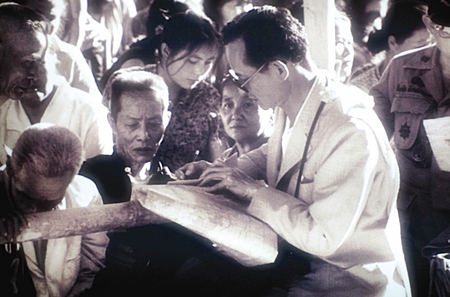
When he was in doubt, HM the King would fly over a particular area, armed with aerial photographs and maps of the terrain, noting features as they passed underneath. And, being a good photographer himself, he also took His own pictures, later to juxtapose them on area charts to obtain a complete and detailed image of the specifics which helped his planning of various development projects.

His Majesty’s insightful approach to local prevailing conditions has enabled him to improvise new theories for agricultural development, to provide guidelines for educating farmers on self-sufficiency, and to solve problems of goitre by feeding iodine into salt roads at strategic points.
In all these works, His Majesty has promoted a simple approach using environmentally friendly techniques and utilizing moderate amounts of locally available resources. For example, before environmentalism became a major force in the development equation, His Majesty was using vetiver grass to prevent erosion, controlling ground water level to reduce soil acidity, and seeding clouds with simple materials such as dry ice, to produce rain.

A ‘Simple’ approach
The King’s philosophy to development problems has been to “keep it simple” – relying on an intimate knowledge of Nature and her immutable law, such as using fresh water to flush out polluted water or dilute it through utilization of normal tidal fluctuations. The ubiquitous water hyacinth too can be ‘harnessed’ to absorb pollutants.
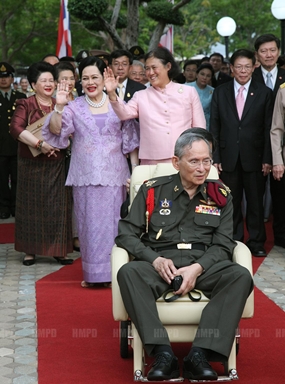
The results of any development, the King asserts, must reach the people directly as a means of overcoming immediate problems, translating into “enough to live, enough to eat”, while looking at a longer-term result of “living well and eating well.”
His Majesty compares this to using adharma (evil) to fight evil, observing that both pollution and the water weed are a menace, but they can be used to counteract each other, thus lessening the damage to the environment.
The King himself practices this ‘simple approach’ and brings a down-to-earth approach to which the people can readily relate. He studies and deliberates exhaustively on the particular project and then reveals his thinking in short, easy-to-grasp titles. The very simplicity belies the profundity of the philosophy, for each title reflects a much deeper insight into a given problem and often, at the same time, hints at the mode of operation to be employed.
The King undertook the establishment of the Royal Development Projects in 1969, primarily as a means of arresting the opium growing and deforestation caused by the Hilltribes’ slash and burn agriculture and to improve their standard of living.
The first was established at a Hmong village on Doi Pui in Chiang Mai Province and now has spread to Chiang Rai, Lamphun and Mae Hong Son. Over the years, the Projects have been instrumental in the conversion of the poppy fields being turned into groves of temperate fruits and vegetables.
Under the dynamic direction of the King’s close colleague, Prince Bhisadej Rajani, who is the Director of the Projects, operating from his base at Chiang Mai University, there are currently four research stations and 35 Royal Project Development Centres which incorporate some 300 villages, comprising 14,000 households and approximately 90,000 farmers.

The Royal Development Projects Board, under the Office of the Prime Minister, also serves as the secretariat for the Chai Pattana Foundation which is directly responsible for the work related to the royal development projects. Now, more than three decades later, the results can be seen in the new life which has come to many of the mountain villages. Greenery has returned to once-denuded forest areas and barren hills and the opium cultivation, a cause of extreme national concern, is virtually a past era.

“The key to the success of the Project lies in His Majesty’s guidelines,” explains Prince Bhisadej. “They focus on obtaining knowledge, through research, avoiding bureaucratic entanglements and swift action to respond to the villagers’ needs, while promoting self-reliance,” he adds. “The effectiveness of this approach has been applauded internationally.” For example, in 1998 the Royal Project won both the Magsaysay Award for International Understanding and the Thai Expo Award for attaining the quality standard of Thai Goods for Export.

HM the King’s own views are that development must respect different regions, geography and peoples’ way of life. “We cannot impose our ideas on the people – only suggest. We must meet them, ascertain their needs and then propose what can be done to meet their expectations,” HM the King pointed out recently.
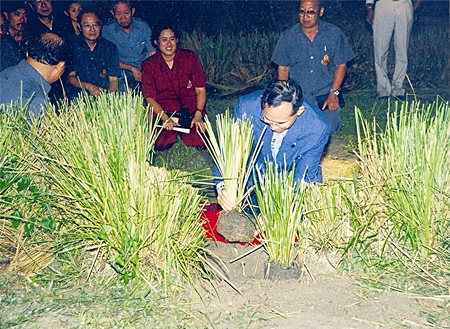
The King’s ideas are in direct contrast to the bureaucracy’s wish to impose standards from the top down, with the inflexibility inherent therein. “Don’t be glued to the textbook,” he admonishes developers “who,” he said, “must compromise and come to terms with the natural and social environment of the community.”
The King sees no need to spare any sensitivities – if there are any – because he feels that the government approach is costly and authoritarian which is why it has “failed miserably to address the country’s problems.”

HM the King: The Royal Sportsman
Throughout the pages of successive years of the Pattaya Mail and the Bangkok Post, as well as such in-fight magazines as Sawasdee, Thailand’s leading yachting correspondent, Peter Cummins, has chronicled the incomparable contributions His Majesty the King has made to the Thai sports men and women and a huge spectrum of Thai sports.

The King’s own example has always been a great source of inspiration to athletes: every sailor knows that His Majesty is a Gold Medal helmsman, winning the OK Dinghy Class in the South East Asian Peninsular Games, 45 years ago on the 16th of December 1967, this day now celebrated as National Sports Day in the Kingdom.
This nautical record is matched by a land-based one, the King being the only person to have lit the torch opening the quadrennial Asian Games on four occasions, last time being in Bangkok in 1998, at the Rajamangala Stadium, just one day after his seventy-first birthday.
For example, when His Majesty trained a magnifying glass on the torch to ignite the flame opening the Thirteenth Asian Games in December 1998, it was symbolic. The Monarch, an ardent supporter of all sports in the Kingdom and elsewhere was, through that simple ritual, figuratively conducting sunlight, and the blessing it brings, onto the Games.
From another viewpoint, His Majesty’s care for the environment and the natural state of the ecology as life support system for his subjects is also well known. What better way to light the torch than using Nature’s own power?
And what better sport for preserving Nature’s gifts, than sailing? A half century ago, the King himself stood on the winner’s podium as a Gold Medallist sailor in the Fourth South East Asian Peninsular Games (Changed in 1975 to the South East Asian Games, when Indonesia and the Philippines were admitted). On that occasion, the King came equal-first with his eldest daughter HRH Ubolratana in the OK Dinghy Section of those Games. It is a sporting record never likely to be equalled. And the King has been an inspiration to Thai athletes for almost five decades since then.

In fact, as is also well known, one of the best yachting festivals in the region – if not the world – is the Phuket King’s Cup Regatta, established in 1987, to honour His Majesty the Regatta’s Royal Patron’s birthday and sailed every December since then, coming up for the 26th series.
In 1987 the Regatta was a first of its kind for Phuket – a multidisciplinary sailing event with international and Thailand-based sailors gathering for some fierce on-water competition and friendly onshore celebrations.

Today, the foundations remain solid and the principles the same. The difference? Twenty six years on the Regatta has grown into the largest sailing event of its kind in Asia, attracting 1,000 plus participants each year a further 1,000 people who take part in the social side. On-the-water, the Regatta regularly sees over 100 boats take part each year.
 At work at Chitralada Villa, building one of his dinghies.
At work at Chitralada Villa, building one of his dinghies.
In 2009, dinghies were re-introduced to the Regatta for the first time since the very early days. This was expanded to include a pre-regatta Phuket Dinghy Series which attracted youth sailors from around Thailand, and concluded with a weekend competition at the King’s Cup. This grassroots development of sailing continues and plans are afoot to bring more Optimists to Phuket for the Phuket Dinghy Series and the King’s Cup, as well as open up the series and King’s Cup to more dinghy classes.
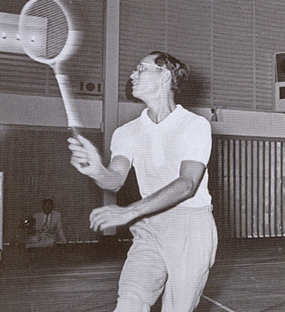
In the big boat classes, the grand prix yachts that compete in the ‘Racing Class’ are now named IRC 0 (formerly the Racing Class), IRC 1, IRC 2 and IRC 3, with split by TCC Handicap rather than design specs.
Bareboat Class and Modern Classic class remain, as does the Premier Class – all with a few subtle tweaks. There are noises of a return of the One Design Platu Class also.
With the new IRC classes, Race Director Simon James recently introduced an IRC National Championship Trophy. All yachts in IRC classes will qualify and after having looked into scoring options and consulted Australian events and IRC itself, a formula has been developed to give overall scores across all IRC classes. This trophy does not replace the Regatta’s class trophies, but is an addition.
More appropriately, regarding HM the King’s total support of Thai athletes and sports generally, no doubt, on the eve of the Southeast Asian (SEA) Games in Indonesia, one can recall the King’s address to a similar gathering, in November 1998. On that occasion, His Majesty addressed the more than 1,000 athletes, officials and support staff who were to participate in the Asiad.
“All sports must be played according to the rules,” His Majesty pointed out to those assembled at Chitralada Palace in 1988. “Show spirit and aim for victory and friendship. If everybody does their best to win in both sports and friendship, the country will benefit,” HM the King added. “A successful Asian Games would show that the enthusiasm of Thai people had not been dulled during their fight against the country’s dire economic crisis,” the Monarch observed. He urged sportsmanship above all else. “Other competitors should not be regarded as enemies, but rather as fellow competitors,” the King concluded.
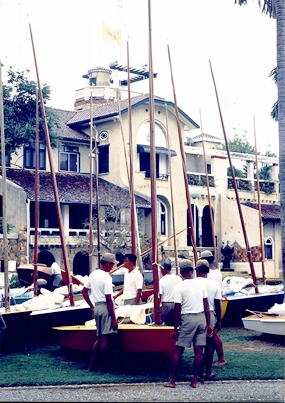 The Royal Chritralada Yacht Squadron, Klai Kangwol Palace: Home of some one hundred OK dinghies.
The Royal Chritralada Yacht Squadron, Klai Kangwol Palace: Home of some one hundred OK dinghies.
Thus, the King has consistently encouraged ALL sportsmen and women EVERYWHERE to “put the sporting spirit first, strive for victory – and friendship.” His own example has always been a great source of inspiration to athletes.
His Majesty is also well known as being highly-knowledgeable about many sports having, at various times, participated himself in skiing, motor racing, ice-skating, badminton, tennis, swimming and even a little golf.
As the then-president of the Thailand Olympic Committee, the late Air Chief Marshal Dawee Chullasapya emphasized when presenting the King with the highly-prestigious honour of “The Insignia of the Olympic Order”, at the Rajanives Hall, Chitralada palace, in December, 1987: “The King is not just a world-class yachtsman, but he has also participated in – and encouraged – many other sports.”
“The Olympic award was made not only to recognize the King’s prowess as a dinghy sailor,” said ACM Dawee, “but also to acknowledge the leading role he has played in promoting all sports – in Thailand, in the region and internationally – always displaying a firm grasp on the history and the finer points of a multitude of sports,” ACM Dawee added. His Majesty is the only reigning Monarch to receive this accolade.
Another Olympic honour was bestowed upon His Majesty in 2001, when the International Olympic Committee presented him with the IOC’s “Lalounis Cup”.
In boxing, too, HM the King has proved to be most knowledgeable. In 2001, president of the World Boxing Council, Dr Jose Sulaiman, in bestowing upon His Majesty the WBC’s “Golden Shining Symbol of World Leadership Award”, was “amazed at the King’s knowledge of boxing”. Whereupon, the King urged Dr Sulaiman “to promote boxing not only as a sport … but also as an art of self-defence.”
In Mexico, August 11, 2003, through the Royal Thai Embassy in Mexico City, HM the King, in turn, bestowed the title of “Second Class Knight Commander of the Most Admirable Order of the Direkgunabhorn” on Dr Sulaiman – one of the highest Royal Awards ever to be conferred on a sports official.
Thailand’s sportsmen and women – particularly the burgeoning army of sailors at sites up and down the Thai coast are, indeed, fortunate to have their own King as an ardent supporter, a leading example and, not the least, the Royal Imprimatur of Thai sports. All who regularly sail at the King’s own Club, the Royal Varuna Yacht Club in South Pattaya heartily agree and salute the Royal Patron on this auspicious occasion.
Epilogue
Thus, through the illustrious decades of his rule, HM the King has been the very embodiment of his Oath of Accession that, “We will reign with Righteousness for the Benefit and Happiness of the Siamese People.”

The world’s longest-reigning Monarch, this week celebrating his eighty-fifth birthday, continues to be, as he has been for the half-century of his just reign, “the light of his land, the pride of his people and a shining example to all peoples of a troubled world.”
All of us at the Pattaya Mail Publishing Company, Pattaya Mail, Pattaya Blatt, Chiang Mai Mail and Pattaya Mail TV, join the Kingdom in wishing His Majesty a most Happy Birthday, long life and our sincerest thanks for allowing a similar celebration of “Fathers’ Day, 2012″ throughout the Kingdom.


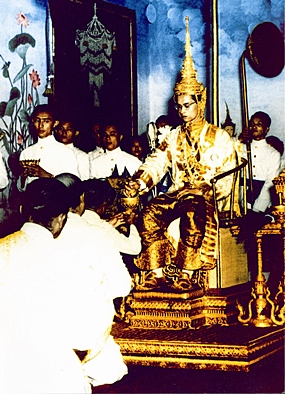 H.M. King Bhumibol Adulyadej’s coronation, 5 May 1950.
H.M. King Bhumibol Adulyadej’s coronation, 5 May 1950.


